
HERE, IN THE SECOND of a long multi-part series, is how we reported the career of Steve Prefontaine in our pages from the fall of ’69 through the summer of ’70, with the same photographs we used at the time. We have taken the liberty of doing some stylistic updatings to mirror our modern protocol and also added an editorial comment or three:
November 1969: XC Roundup
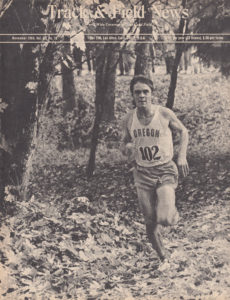
… Pacific Coast: For a team giving little emphasis to cross country and running its first meet of the year, Oregon made quite a showing in the Northern Division (of the Pac-8) race. And for his first-ever 6M, Steve Prefontaine did the same. Oregon’s runners, the only ones to wear spikes on the slippery, leaf-covered course at Oregon State which also involved some hard-surfaced areas, got 5 of the first 6 places and a surprisingly easy victory over highly-regarded Washington State, 19–44.
Freshman Prefontaine went ahead early on the grass, watched Gerry Lindgren burn by and build a 60y lead on the second and third miles of asphalt, then gained it all back—pIus 150y—as they got back on grass and Lindgren found the going too treacherous. Gerry didn’t fall, but said he had to nearly stop three or four times to keep from it. Prefontaine ran 29:13.8, Lindgren 29:41. Then came Oregon’s pack: 3. Steve Savage 29:59; 4. Mike McLendon 29:59; 5. Norm Trerise 30:02; 6. Tom Morrow 30:06. Rick Riley of Washington State was 7th in 30:18. /Bob Payne/
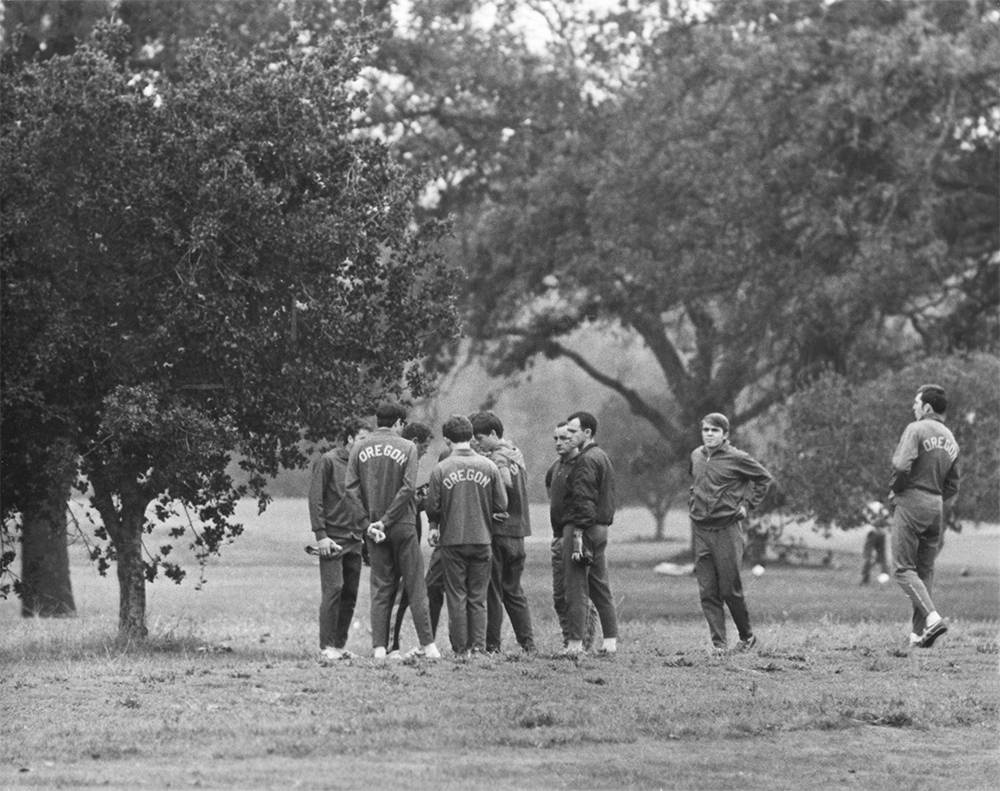
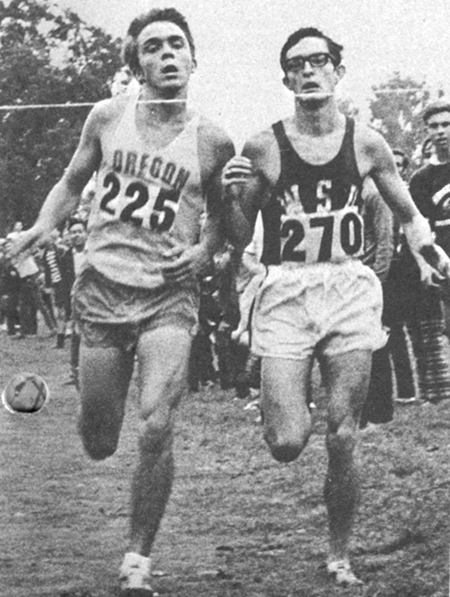
November 1969: Lindgren,
Prefontaine in Near Tie
Stanford, California, November 15—Gerry Lindgren and Steve Prefontaine traded stride-for-stride throughout the 5.9M of the first Pacific-8 XC Championship, but at the finish line it was the indefatigable Lindgren who prevailed over the sensational Prefontaine.
Both runners clocked 28:32.4 over the hilly, but fast, route on the Stanford golf course, leading 26 runners under 30:00 and 19 under the old course best of 29:46.4 by Stanford’s Brook Thomas. Oregon jammed 4 men into the top 10 for 46 points and the team title, besting Washington State’s 63.
Prefontaine sprinted off the starting line as though he had a fifth of the distance to run and Lindgren went right after him. The two diminutive distance giants immediately opened a wide gap on the remainder of a quality field and by the mile post, passed in approximately 4:23, had about 80y on the second group.
The two seesawed back and forth in the lead, building up 200y on the field. Steve Savage of Oregon, Rick Riley of Washington State and Greg Brock of host Stanford led the second bunch. As Gerry and “Pre” closed in on the finish, they were running as one. Down the finish chute, they bumped and crossed the line virtually in a dead heat. Neither man, however, said he was trying to tie, as it appeared to many observers.
“I was going all out,” Prefontaine said later. “We didn’t plan to tie. I felt I had to go fast from the start because Gerry is fast.” Lindgren, beaten by the Oregon freshman two weeks ago in the Northern Division, commented, “I planned to go after Steve and stay with him at first. I wanted to go by him and leave him several times but I couldn’t.” /Jon Hendershott/
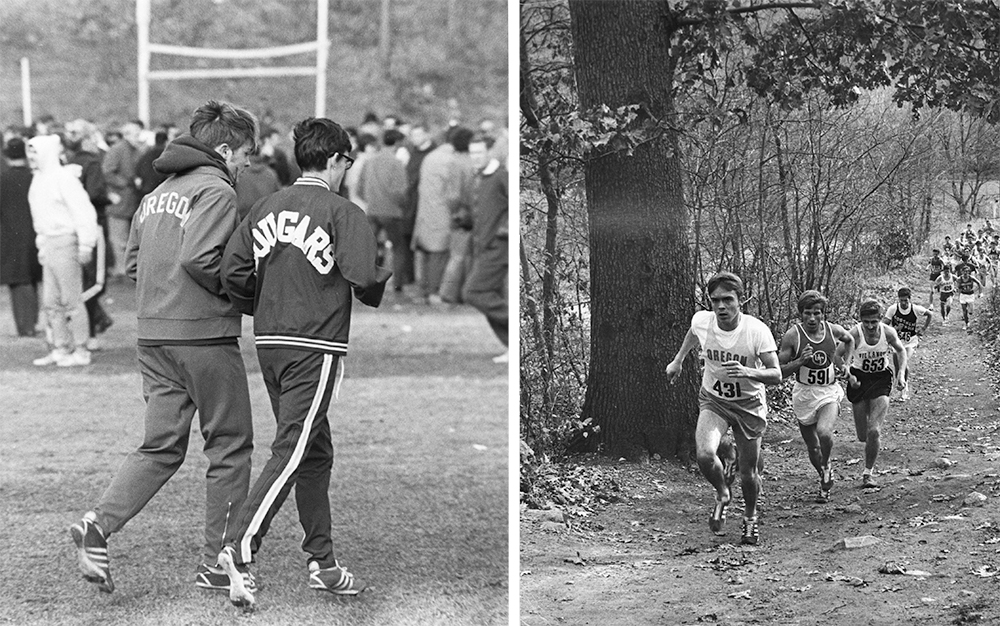
December 1969: NCAA—Lindgren Holds off Ryan
Bronx, New York, November 24—Gerry Lindgren, his glasses steamed up most of the way, won his third NCAA cross country championship over Van Cortlandt Park’s 6.0M course today.
Lindgren led all the way, opening up as much as 60 or 70y on his pursuers, but had to sprint at the end to hold off the finish of defending champion Mike Ryan of the Air Force Academy. The 120lb Lindgren was timed in 28:59.2, breaking Ryan’s year-old course record of 29:16.8. Ryan, 2nd in 29:01, and Steve Prefontaine, 3rd in 29:12, were also under the old mark. “I was scared, really scared,” said Lindgren, “so I wanted to lead all the way. I didn’t look back at all,” he added, stealing a line from Satchel Paige. “I was afraid I might see somebody gaining on me.”
Leading the chase much of the way was Oregon superfrosh Prefontaine, who had beaten Lindgren earlier in the Pac-8’s Northern Division race and barely lost to him in the conference championship. “I don’t know what happened,” said Prefontaine. “I like a fast pace, but I just wasn’t right today. Gerry’s time at 3M was 14:14, but in both other races this year I’ve hit 3M in about 14:00 flat… and on tougher courses.” /Jim Dunaway/ — Click here for meet results —
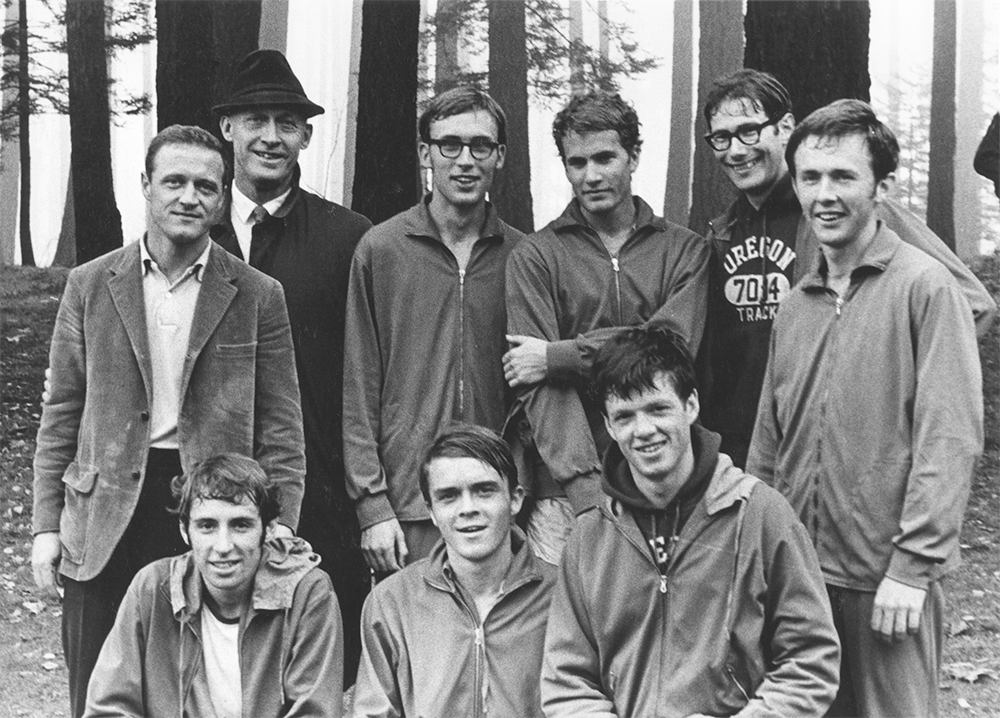
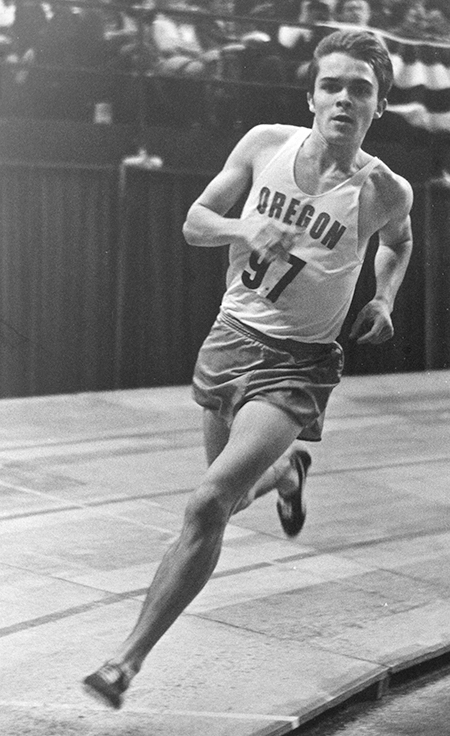
January 1970: The U.S. Rankings
Making the first of what would be 7 appearances in the 3M/5000 charting, Pre debuted as No. 3 for ’69.
I February 1970: Prefontaine, Hines Snatch U.S. Leads
Portland, Oregon, January 31—Early efforts from Henry Hines, Randy Matson and Steve Prefontaine settled competitive arguments in their favor and highlighted the 10th annual Oregon Invitational…
Although he had been hit by the flu the past week, Prefontaine said before the 2M he was “hoping for around 8:40.” With an enthusiastic “hometown” crowd urging him on, the Oregon freshman forged his own pace on the 11-lap banked board track. He passed the mile in 4:21 and came home in 8:39.2, a personal best ever. A closely-bunched crowd finished behind Prefontaine with Oregon State’s Spencer Lyman (8:47.4) edging Norm Trerise (8:47.6) and Steve Savage (8:47.8). /Don Jacobs/
I April 1970: News Roundup
… Another frosh, Steve Prefontaine of Oregon, wasted no time in demonstrating his prowess with an 8:40.0 two-mile victory at Fresno, March 21… A week later “Pre” turned in a 13:48.8 three-mile at El Paso.
II April 1970: News Roundup
In Pac-8 dual meet action Oregon frosh Steve Prefontaine doubled in 4:05.3 and 8:46.4 against UCLA before a crowd of 10,200 at Eugene.
[Ed: the Outdoor Report also noted a 4:03.2/8:51.2 double vs. Washington plus a 13:30.6 against Cal.]
I May 1970: Prefontaine Predominant New Distance Force
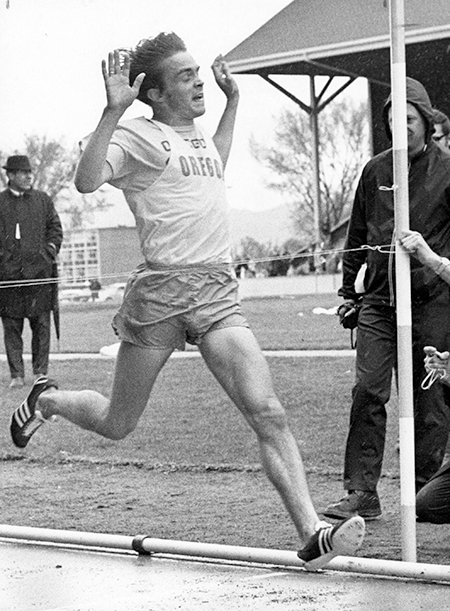
Eugene, Oregon, April 25—When Steve Prefontaine went to bed on the evening of the 24th he led the US over 3M, but when he awoke the following day, he discovered that he had been usurped by Jack Bacheler’s 13:13.4 at Drake. That afternoon undaunted by adverse conditions such as rain, high winds, and a temperature of only 40°, the gritty Oregon frosh still recorded 13:12.8 [against Washington State], the seventh-fastest time ever by an American. Pre is still only 19 years old.
[Ed: at a time when T&FN came out every 2 weeks during the peak U.S. season, there was more detail on this race in the next month’s issue.]
II May 1970: Outdoor Report, 3M
On a raw, cold, windy, rainy day in Eugene, Oregon, Steve Prefontaine became the seventh-fastest U.S. 3-miler in history as he toured 12 laps in 13:12.8. Prefontaine planned to pass the 2M mark in about 9:00—but obviously changed his race plan and hurried by 8 circuits in 8:45 (4:17, 4:28).
“I felt that if I passed 2M in 9:00, I would try to go the last mile in 4:10,” he said later. “But after the first halfmile, my rhythm was going good and I felt good and after the first mile, I thought, ‘I’m not slowing down to a 9:00 pace now’. Before the race, I really wasn’t sure what I could do because I’d had a cold all week. So I felt if I could cross 2M in 9:00 and then run 4:10 or 4:15, I would have a 13:10 or 13:15 and I would be happy with that.”
His final four laps took 4:27.8. “And I had so much left,” he commented. “I felt like I should have made my sprint earlier.” The Oregon freshman characterized himself as “completely different” from the high school senior who broke the national prep 2M record a year ago. “I was running pretty well last year at 18,” he said, “but they say you get stronger as you get older. If I keep getting this much stronger every year, I don’t know what I’ll be doing. Plus I feel faster and more confident.”
II May 1970: Outdoor Report, Mile
Steve Prefontaine assumed the national mile lead just a week after he established leadership in the 3M. His 4:00.4 [against Oregon State] makes him the 10th-fastest miler in Oregon history. [He had preceded that with a 4:05.3/8:46.4 double against UCLA.]
II May 1970: Pac-8 Championships
Westwood, California, May 16—…Any thoughts that Steve Prefontaine might have had of record running were probably dampened by the intense heat, but he still recorded a good-for-the-conditions 13:27.8. He had established a 5y lead by the first quarter post and added extra chunks on every circuit until he had built nearly a 60y lead as he passed the 2M marker in 8:52.6. In the next three laps, he slowed to the 68-69 range, and had his lead cut to about 50y.
Meanwhile, Southern Cal’s Ole Oleson, who has shown himself to be a fine championship runner, worked his way into striking distance beside Don Kardong of Stanford. As they entered the bell lap, Ole began a mighty sprint. If Pre had not turned around on the backstretch and noticed Oleson, the young Oregonian might have been caught napping. As it was, Pre put on a scared-rabbit sprint, which gave him his 4-second triumph with a 60.1 last lap to Ole’s 56.6. /Garry Hill/
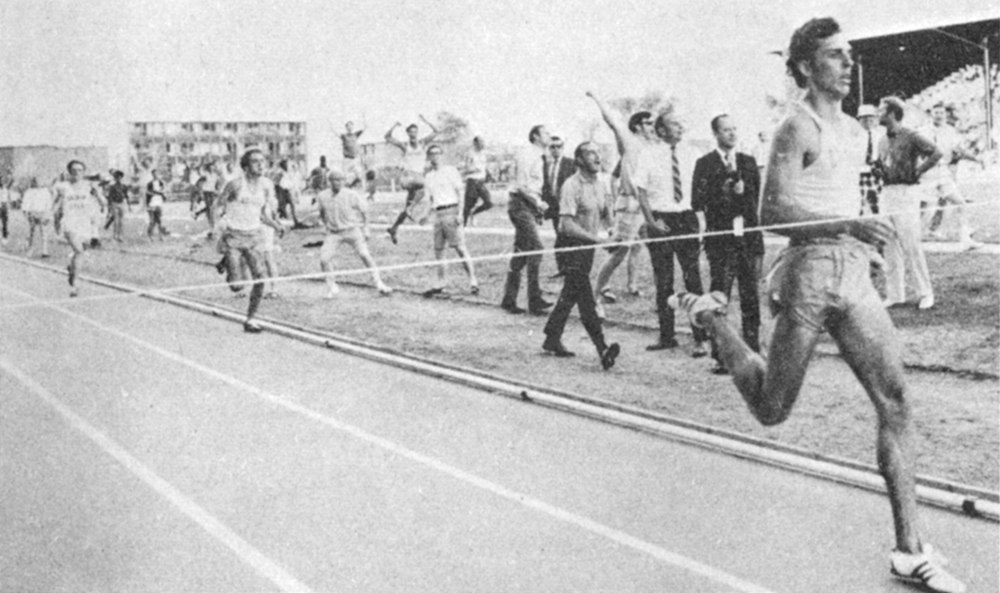
II June 1970: Oregon Twilight
Eugene, Oregon, June 5—Four-minute miles are almost commonplace at the University of Oregon, but a special twilight meet here produced an uncommonly fast finish as Roscoe Divine socked the world’s quickest time this year to 3:56. 3.
Divine led an impressive parade of 5 men under 4:00 and 6 of the 7 finishers to personal bests. Steve Prefontaine slashed his best drastically to 3:57.4 in 2nd, Dave Wilborn missed his best by 2 seconds with a 3:58.2 in 3rd, Norm Trerise clocked 3:59.1 in 4th and steeplechaser Steve Savage destroyed his former best of 4:06.4 with 3:59.2 in 5th. What’s more, sixth man Bob Rhen improved to 4:01.6 from 4:05.0 in 6th and Tom Morrow brought up the rear in yet another PR, 4:01.8 for 7th.
This sizzling 4-Iap contest capped an evening of personal record busting in a meet which dedicated Oregon’s new all-weather track. But for the 8400 spectators who turned out in warm, sunny weather, the mile was the highlight of the abbreviated program.
Yet another Oregon miler, Wes Smylie, led the field past the first 440 post in 59.0, quick but not sensationally so. Then steepler Jim Gorman took over and at the halfway mark the pace had slowed to 2:01. That was too slow for Prefontaine and Wilborn who assumed command but still didn’t increase the pace noticeably, the 1320 going by in 3:02.
All this time, Divine was biding his time slightly arrears. But 165y from home, he burst past Prefontaine and came home with a 54.3 final 440 for his fastest clocking since 3:57.2 in 1967. “For the first time this year I was really confident,” Divine said later. “I was loose and I knew somebody would have to run like hell to beat me.”
Even the runners who ran that way couldn’t overcome Divine, though. As Savage commented, “Things are really tough when you have to run under 4:00 to get 5th in a race.”
Divine was clocked at 3:41.2 at the 1500m mark. It is notable that Oregon had three currently enrolled athletes under 4:00 here. Prefontaine and Savage became the ninth and tenth Oregon runners to duck under 4:00; Divine is the second-fastest Oregon miler in history (behind only Wilborn’s 3:56.2 in ’67) and Prefontaine is third.
I July 1970: NCAA 3M
Des Moines, Iowa, June 30—Runners were on the track, warming up for the first 3M heats in meet history when a last-minute scratch narrowed the field to 20 to make heats unnecessary.
In Saturday’s final, Don Rowe of St. John’s led in 67.0 and 2:14.0. Then, stocky Steve Prefontaine sent Oregon’s green and lemon colors to the front. He set an easy pace which allowed many runners to stay in the first division. Prefontaine passed the mile in 4:28.8 and 2M in 9:03.0. At that point, he was closely followed by another freshman, Garry Bjorklund of Minnesota, IC4A champ Dick Buerkle of Villanova, Jay Mason of Kansas, little Ed Norris of Kent State, Greg Fredericks of Penn State, bearded Martin Robb of Providence, tall Don Kardong of Stanford and Rowe. Ten yards behind Rowe were redheaded Doug Scorrar of Ohio State and defending champion Ole Oleson of Southern Cal.
The 69-second pace continued, and Rowe fell back. With 2 laps to go, in 11:21.6, Buerkle and Bjorklund moved alongside Prefontaine and the racing began. Buerkle tried to break it open, but the other two stayed on his heels. At the gun, Kardong was 22y behind Bjorklund and 3 ahead of Fredericks.
Prefontaine led Bjorklund and Buerkle by 5y on the backstretch. Then the great freshman began a hard sprint and he pulled away rapidly. He looked back in mid-turn, but he did not slow down even though he won by over 20y. His last 880 was in a startling 2:00.4 and his final quarter in 57.7 for a 13:22.0 overall.
Bjorklund, only 18 years old, ran his last 880 in 2:03.9 and beat Buerkle by 2.2 seconds in 13:25.6. Kardong put on a fast finish and almost caught Buerkle from 30y behind on the backstretch for a 13:28.0. Fredericks lost only about 2 more yards to Kardong in the last half-lap and still bettered the meet record with his 13:30.0. The others fell far behind.
Prefontaine had split the web in between two toes in a swimming accident, and he ran with 7 stitches in it. “I had the foot padded and taped,” he said after the race. “I haven’t looked at it yet, I’m kinda scared to do it. My foot really didn’t bother me during the race, just during the last 165y.”
Even though his 13:22.0 broke Gerry Lindgren’s meet record by almost 12 seconds, Prefontaine said, “Why should I take off early when I can run an easier race and sprint at the end? I wasn’t running for time today. I was glad someone else took the pace there for a while. I knew it would depend on the last quarter, and I knew I was faster on that than the rest.” /Cordner Nelson/ — Race results in this file —
1 July 1970: AAU 3M
Bakersfield, California, June 27—As usual in a slow, tactical race, some of the endurance-type runners regretted it. After a mile in 4:30.8 and 2M in 9:05.2, 13 runners were closely bunched. And another halfmile in 2:19.3 shook off only two runners.
They began to worry a little then, and the pace picked up to 63.5, with seven runners in contention. Tarry Harrison took the lead past the stands, but Gerry Lindgren, in an all-red uniform, burst past Harrison at the bell in 12:28.0. Lindgren was almost sprinting around the curve and had a 3y lead over Steve Prefontaine. On the backstretch, Prefontaine made a quick move and closed the gap. Minnesota’s great 18-year-old Garry Bjorklund moved with Prefontaine, ahead of Frank Shorter and Jack Bacheler. There was a 2-yard gap to Rick Riley and 2 more to Harrison. Bjorklund moved inside of Prefontaine and they jostled each other. Shorter rushed past Lindgren as the two freshmen faded, and Bacheler passed them.
Into the homestretch Riley began a beautiful, fast drive. On the same track where he first came to national attention five years ago as a high school junior, Riley flowed past Bjorklund, past Prefontaine. He ran inside Bacheler. He caught his old friend, Lindgren, with about 40y to go and beat him for the first time in major competition. Lindgren was tying up at that point and Bacheler was bearing down on him with giant strides, but Bacheler, too, faltered near the end and Lindgren held 3rd place.
Their last laps decided the race. Shorter clocked 55.8 for the final circuit as his 13:24.2 edged Riley by two 10ths. One watched clocked Riley at 54.7 and Lindgren and Bacheler ran 57.0 each. Prefontaine and Bjorklund timed 57.8 and 58.4 respectively. Shorter and Riley both ran the final halfmile somewhere under 2:00.
Prefontaine said his foot, injured before the NCAA, hurt him before the race. After the race a doctor looked at it and said, “I don’t see how he could run on it.” /Cordner Nelson/ — Race results in this file —
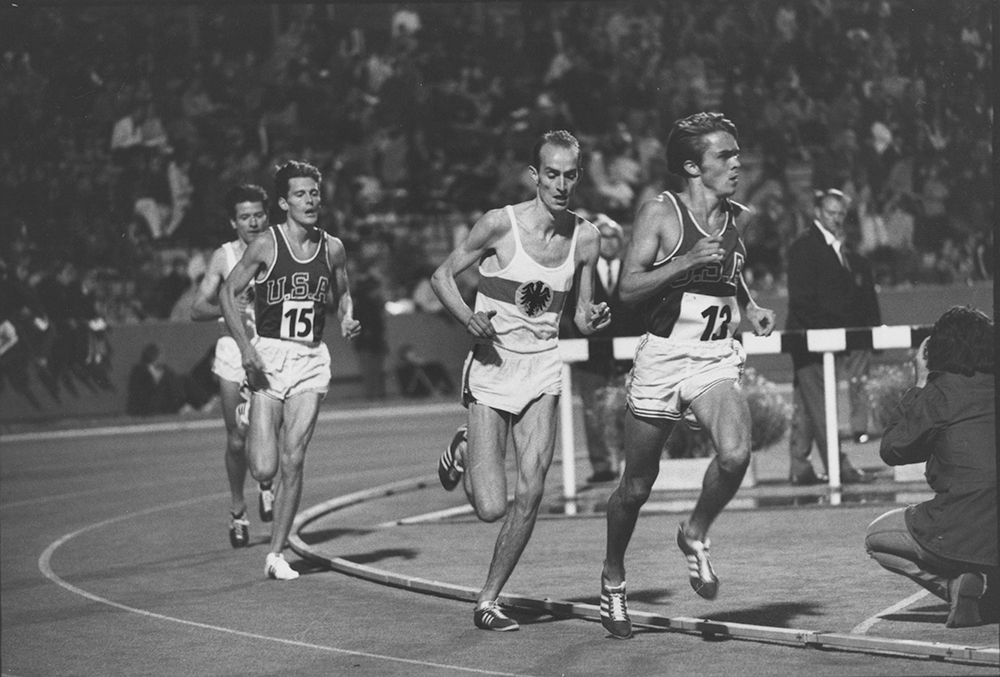
II July 1970: U.S. vs. West Germany
Stuttgart, West Germany, July 16—… Steve Prefontaine set the pace for all but 250m of the 5000. That’s when the leaching Harald Norpoth streaked by, opened up a big margin and won, 13:34.6 to 13:39.6. “I don’t have much respect for a runner who’d let a kid do all the work and then go by in the end,” said Steve afterwards. /Dick Bank/
[Ed: It went unremarked in the magazine, but a week later in the U.S. vs. Soviet Union meet Pre took 2nd in the 5000, ending a long first year at Oregon.]
Previously…
Part 1: The High School Years